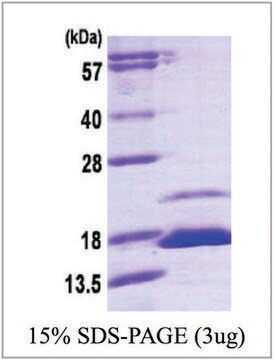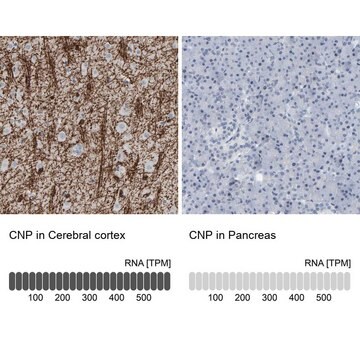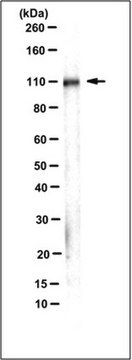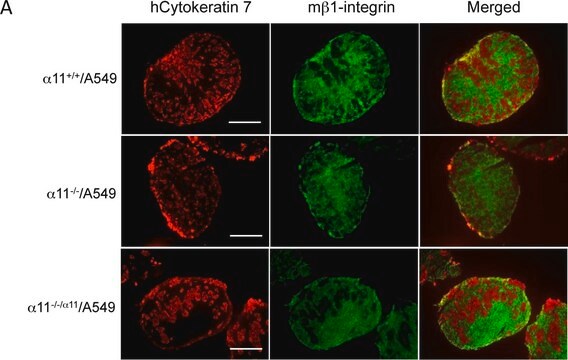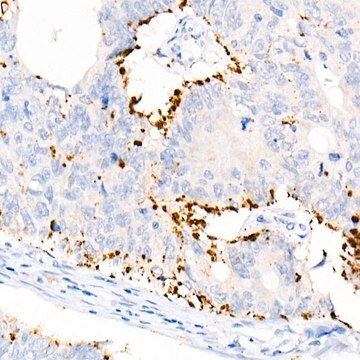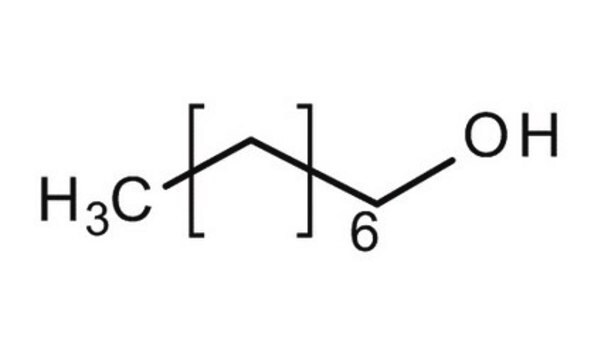SRP6063
PIN1 human
recombinant, expressed in E. coli, ≥95% (SDS-PAGE)
Synonim(y):
DOD, NIMA-interacting protein 1, PPIase Pin1, Rotamase Pin1, UBL5
Zaloguj sięWyświetlanie cen organizacyjnych i kontraktowych
About This Item
Polecane produkty
pochodzenie biologiczne
human
rekombinowane
expressed in E. coli
Próba
≥95% (SDS-PAGE)
Formularz
liquid
masa cząsteczkowa
18.2 kDa (163 aa)
opakowanie
pkg of 100 μg
numer dostępu NCBI
Warunki transportu
dry ice
temp. przechowywania
−70°C
informacje o genach
human ... PIN1(5300)
Opis ogólny
PIN1 (peptidylprolyl cis/trans isomerase, NIMA-interacting 1) is a peptidyl prolyl cis-trans isomerase. It is a conserved eukaryotic protein that contains an amino-terminal WW domain, which functions as a phosphorylated serine or threonine residue-binding site. Its C-terminal domain functions as the enzymatic domain, and is responsible for catalyzing the cis/trans isomerization of pSer/Thr-Pro bonds.
Działania biochem./fizjol.
PIN1 (peptidylprolyl cis/trans isomerase, NIMA (never in mitosis A)-interacting 1) associates specifically with the phosphoserine-proline or phosphothreonine-proline residues immediately preceding proline (pSer/Thr-Pro), and promotes cis/trans isomerization of the peptide bond. This protein is involved in the amplification of the phosphorylation signaling, and is involved in catalyzing target dephosphorylation, control of protein stability and ubiquitination. It also mediates the cellular localization of its target proteins. It is highly up-regulated in multiple types of cancers, such as breast and prostate cancer, and is essential for the functionality and cross-talk of tumorigenic pathways. It is also implicated in Alzheimer′s disease (AD) and asthma.
Postać fizyczna
1 mg/mL solution in 20 mM Tris-HCl buffer (pH 7.5) containing 100 mM NaCl, 5 mM DTT, 20% glycerol.
Uwaga dotycząca przygotowania
Centrifuge the vial prior to opening.
Inne uwagi
MADEEKLPPG WEKRMSRSSG RVYYFNHITN ASQWERPSGN SSSGGKNGQG EPARVRCSHL LVKHSQSRRP SSWRQEKITR TKEEALELIN GYIQKIKSGE EDFESLASQF SDCSSAKARG DLGAFSRGQM QKPFEDASFA LRTGEMSGPV FTDSGIHIIL RTE
Ta strona może zawierać tekst przetłumaczony maszynowo.
Hasło ostrzegawcze
Warning
Zwroty wskazujące rodzaj zagrożenia
Zwroty wskazujące środki ostrożności
Klasyfikacja zagrożeń
Eye Irrit. 2
Kod klasy składowania
10 - Combustible liquids
Klasa zagrożenia wodnego (WGK)
WGK 3
Wybierz jedną z najnowszych wersji:
Certyfikaty analizy (CoA)
Lot/Batch Number
Nie widzisz odpowiedniej wersji?
Jeśli potrzebujesz konkretnej wersji, możesz wyszukać konkretny certyfikat według numeru partii lub serii.
Masz już ten produkt?
Dokumenty związane z niedawno zakupionymi produktami zostały zamieszczone w Bibliotece dokumentów.
Guo-Liang Huang et al.
Cell death & disease, 7(12), e2571-e2571 (2016-12-30)
The function of activating transcription factor 1 (ATF1) and the mechanism about why ATF1 was over-phosphorylated in nasopharyngeal carcinoma (NPC) progression is completely undiscovered. In this study, a series of experiments both in vitro and in vivo were used to
Pin1 is related with clinical stage of papillary thyroid carcinoma.
Jiang L et al
World Journal of Surgical Oncology, 14, 95-95 (2016)
Peptidyl-Prolyl cis/trans Isomerase NIMA-Interacting 1 as a Therapeutic Target in Hepatocellular Carcinoma.
Kim G et al
Biological & Pharmaceutical Bulletin, 38(7), 975-979 (2015)
Pin1 induction in the fibrotic liver and its roles in TGF-β1 expression and Smad2/3 phosphorylation.
Jin Won Yang et al.
Journal of hepatology, 60(6), 1235-1241 (2014-02-18)
Therapeutic management of liver fibrosis remains an unsolved clinical problem. Hepatic accumulation of extracellular matrix, mainly collagen, is mediated by the production of transforming growth factor-β1 (TGF-β1) in stellate cells. Pin1, a peptidyl-prolyl isomerase, plays an important pathophysiological role in
Garam Kim et al.
Molecular carcinogenesis, 54(6), 440-448 (2013-11-23)
Pin1, a conserved eukaryotic Peptidyl-prolyl cis/trans isomerase, has profound effects on numerous key-signaling molecules, and its deregulation contributes to disease, particularly cancer. Although Pin1-mediated prolyl isomerization is an essential and novel regulatory mechanism for protein phosphorylation, little is known about
Nasz zespół naukowców ma doświadczenie we wszystkich obszarach badań, w tym w naukach przyrodniczych, materiałoznawstwie, syntezie chemicznej, chromatografii, analityce i wielu innych dziedzinach.
Skontaktuj się z zespołem ds. pomocy technicznej